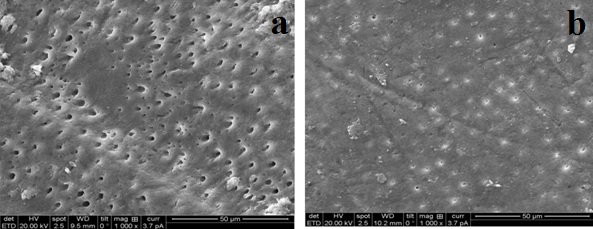An In-vitro Comparison of Nano Hydroxyapatite, Novamin and Proargin Desensitizing Toothpastes - A SEM Study
Rithesh Kulal1, Ipsita Jayanti2, Savita Sambashivaiah3, Shivaprasad Bilchodmath4
1 Reader, Department of Periodontology, Rajarajeswari Dental College and Hospital, Bengaluru, Karnataka, India.
2 Lecturer, Department of Periodontics and Oral Implantology, Kalinga Institute of Dental Sciences, Bhubaneswar, Odisha, India.
3 Professor and HOD, Department of Periodontology, Rajarajeswari Dental College and Hospital, Bengaluru, Karnataka, India.
4 Reader, Department of Periodontology, Rajarajeswari Dental College and Hospital, Bengaluru, Karnataka, India.
NAME, ADDRESS, E-MAIL ID OF THE CORRESPONDING AUTHOR: Dr. Rithesh Kulal, Reader, Department of Periodontology, Rajarajeswari Dental College and Hospital, Bengaluru-560074, Karnataka, India.
E-mail: rithesh14@yahoo.com
Introduction
Dentinal Hypersensitivity (DH) is commonly encountered clinical condition in dental practice which affects 8-57% of the adult population presenting for dental treatment, but the treatment of the same remains doubtful.
Aim
The purpose of this study was to evaluate and compare the effects of three different desensitizing agents (15% nano hydroxyapatite crystals; 5% novamin and 8% proargin) on dentinal permeability and tubule occlusion in-vitro. Scanning Electron Microscope (SEM) was used to evaluate the effect of these commercially available desensitizing toothpastes.
Materials and Methods
A total of 40 disc shaped dentin specimens were disdivted from extracted premolars. Dentin discs of 1mm were obtained with the help of diamond discs. Ten specimens were randomly selected and allocated to the evaluation groups A (control group), B (Nano-hydroxyapatite), C (Novamin) and D (Proargin). Each treatment group dentine disc specimen was treated with the respective slurry for two minutes for a period of seven days. Each disc was subjected to a pre- and post-treatment SEM analysis to evaluate the changes occurring in the dentinal tubules.
Results
The qualitative analysis showed no occlusion of the dentinal tubules in Group A (control group) and Group B (nano-hydroxyapatite) showed 98.1% tubule occlusion. Group C (Novamin) and D (Proargin) showed 83.1% and 69.1% tubule occlusion respectively. Quantitative analysis showed a statistical significant difference between Group B and D (p< 0.005) and no statistical significant difference between group B and C (p= 0.235). Similarly, there was no significant difference between Group C and D as (p=0.235).
Conclusion
It was concluded that all the three desensiting agents were effective in the dentine tubule occlusion. In addition efficacy of nano-hydroxyapatite toothpaste was greater compared to the other desensiting agents.
Introduction
Exposure of the root area due to chronic trauma from toothbrushing, parafunctional habits, periodontal diseases and acidic dietary components are common causes of cervical lesions and dentinal hypersensitivity [1]. Dentinal Hypersensitivity (DH) is one of the commonly encountered clinical conditions in the day to day dental practice. It affects the adult population from about 8-57% presenting for dental treatment [2].
DH is defined as “the short exaggerated, painful response elicited when exposed dentin is subjected to certain thermal, mechanical or chemical stimuli [3]. Dentinal tubules play a major role in transferring stimuli and irritants to the pulp. Hydrodynamic theory proposed by Braennstroem and Astroem in 1964 which explains that the pain caused by DH is most widely accepted [4]. This theory states that, the occurrence of lesions involving enamel or cementum loss in cervical areas and subsequent opening of dentinal tubules to the oral environment under certain stimuli allow the movement of dentinal fluid inside the tubules indirectly stimulating the extremities of the pulp nerves causing the pain sensation [5].
Numerous methods have been employed for the clinical treatment of hypersensitive dentine including ions and salts, fluoride iontophoresis, dentin sealers, periodontal soft tissue grafts and lasers [6]. Presently blockage of nerve activity and tubular occlusion are two main approaches used in the treatment and prevention of DH: the first approach involves the use of potassium ions which interfere in nerve transmission by depolarizing the nerve fibres [7]. The second modality of treatment approach involves mechanical occlusion of the dentinal tubules by physical or a chemical agent which prevents the pulpal fluid flow and reduction in DH [8]. This results in rendering the dentin resistant to mechanical and chemical insult. These treatment approaches are able to achieve this by firstly elevating the mineral density of the dentin surface making it resistant to wear. The other approach physically plugs the open tubules with a calcium and phosphate containing dentine like substance which blocks the diffusion through the tubules into the dentin sub-surface [9].
Recently novel biomaterials like the bioactive glass, proargin and nano-hydroxyapatite crystal have been introduced in the treatment of DH. A specially formulated dentifrice containing bioactive glass particles have also shown to occlude dentinal tubules, providing substantial relief from DH. The bioactive glass based toothpaste is commercially available as Novamin. It reduces sensitivity by blocking open tubules and by supplying calcium (Ca2+) and phosphate (PO43–) ions in an optimum environment to form Hydroxycarbonate Apatite (HCA), that is chemically and structurally equivalent to biological apatite [10,11].
Proargin system is based on the natural process of tubule occlusion. The proargin system consists of arginine, an amino acid which is positively charged at physiological pH, bicarbonate-pH buffer and calcium carbonate acts as a source of calcium. The interaction of arginine and calcium carbonate at physiological pH results in the formation of a calcium rich layer which binds to the negatively charged dentine surface resulting in the plugging of dentine tubules and blocking diffusion of fluids [12]. The components maintain the alkaline pH and the resulting glycoprotein formed during the interaction of the components helps in tubule occlusion [13].
In a study, 10% nano-hydroxyapatite solution was able to remineralise artificial carious lesions [14]. This biofunctional material has both desensitizing and remineralizing potential for treatment of DH. The surface density of dentinal tubules of hypersensitive teeth is higher and larger compared to non-sensitive teeth [15]. The Scanning Electron Microscopy (SEM) images of 10% and 15% nano-hydroxyapatite treated dentine surface has showed that the entire dentine surface was covered by precipitate layer deposit of nano-hydroxyapatite thereby plugging and forming a protective layer on the surface of dentine [16].
Clinical trials have evaluated these novel biomaterials in treatment of DH. This study is an in-vitro comparison of the three novel biomaterials that have been applied in the treatment of DH and SEM was used to evaluate and compare changes in tubule dimensions after the application of the desensitising agents.
Materials and Methods
Preparation of Dentine Discs [17]: In the current in-vitro study 40 extracted human premolars and molars were included all of which had been extracted for orthodontic reasons. All the teeth were collected after donors informed consents were obtained according to the protocol approved by the ethical committee of Rajarajeswari Dental College and Hospital, Bengaluru, Karnataka, India.
Inclusion criteria: 1. Caries free crown and root surface
2. Roots without any abrasion or erosion
Teeth with history of scaling in last six months and endodontically treated teeth were excluded from the study.
Sample Preparation: All the extracted teeth were stored in 10% formalin at room temperature. The teeth were cleaned for debris and tissue. Using plain cut tungsten carbide fissure burs the enamel was removed at high speed under a continuous water spray and crown dentin discs, with a thickness of 1mm, were prepared by cutting perpendicular to the long axis of tooth. The dentin discs were polished with carborundum paper and were washed with distilled water. Each specimen was etched with 30% phosphoric acid for 15 minute to remove any smear layer from the grinding process and open the dentine tubules to simulate dentine hypersensitivity. All the discs were stored in distilled water. A total of 40 dentin discs of 1mm thickness were divided into four groups of 10 specimens each according to the surface treatment.
Group A: Control Group: consisted of dentin discs immersed in normal saline
Group B: Nano-hydroxyapatite Group
Group C: Novamin Group
Group D: Proargin Group.
The test specimens were treated with the desensitizing agents as per the manufacturer’s instructions [Table/Fig-1]. The discs were subjected to a pre-treatment SEM analysis. Each treatment group dentine disc specimen was treated with the respective slurry for two minutes for a period of seven days [18]. Subsequent to the treatment, the specimens were dried and prepared for analysis by SEM. After drying, the discs were mounted onto aluminium stubs and subsequently coated with a thin layer of gold/palladium in a sputter coater. Photographs of the samples were obtained from the camera which was fixed to the SEM. The surface of the samples were scanned and examined using SEM (JEOL Model 5400, JEOL Co., Tokyo, Japan) at 1000X and 20kV. The total number of tubules, open tubules, completely occluded tubules and partially occluded tubules were calculated in each image of all of the samples.
Desensitizing agents and compositions.
| Group | Product and Manufacturer | Composition |
|---|
| Group B | Acclaim, Group Pharmaceuticals Ltd. Malur, India | 1% Nano-hydroxyapatite |
| Group C | Shy NM, Group Pharmaceuticals Ltd. Malur, India | 5% Calcium sodium phosphosilicate |
| Group D | Colagate sensitive pro-relief, Colgate-Palmolive India Ltd., Solan H.P., India. | 8% arginine, calcium carbonate, and 1450 ppm fluoride as sodium monofluorophosphate |
Statistical Analysis
The number of tubules evident in each of the 1000X images was counted to provide a measure of tubule occlusion efficacy. Both the fully-open tubules and the partially-open tubules were included in the count. Firstly the percentage was taken and then converted into probit value for transforming into standard normal variate. Bonferroni test was carried out for comparison of the desensitizing toothpastes. ANOVA test was used to test whether there exists any statistically significant differences among three groups in occlusion of tubules.
Results
All the three desensitising agents were able to achieve dentinal tubule occlusion, however Group A i.e., control group there was no occlusion of the dentinal tubules. Group B showed 97.62% occlusion of the tubules. Group C showed 81.9% tubule occlusion and 65.42% in Group D. On comparison of the desensitising toothpastes, it was observed that there was a statistically significant difference among the three desensitizing toothpastes (F=8.362, p=0.005) [Table/Fig-2]. There was a statistical significant difference between Group B and D (p-value< 0.005). Furthermore, as the mean difference between Group B and D was 0.83, Group B was more efficacious as compared to Group D. There was no statistical significant difference between Group B and C (p=0.235). Similarly, there was no statistical significant difference between Group C and D as (p=0.154) [Table/Fig-3].
Percentages of completely occluded tubules and comparison of efficacy of the desensitizing toothpastes in occluding tubules by One-Way ANOVA.
| Group | Mean no. of Open Tubules | Mean no of Occluded Tubules | % of Completely Occluded Tubules | % to Probit* | Sum of Squares | df | Mean Square | F-statistic | p-value |
|---|
| Group A | 150 | 21.75 | 15.3% | 4.33 | 7.774 | 2 | 3.887 | 8.362 | 0.005# |
| Group B | 158 | 154.4 | 97.62% | 7.1644 |
| Group C | 181.4 | 150.2 | 81.9% | 6.3344 |
| Group D | 152.4 | 99.6 | 65.42% | 5.402 |
* Transformation of percentage to probit values
#Significant at 5 % level
Bonferroni post hoc tests for tubule count data.
| Groups Compared | Mean Difference | Standard Error | Significance |
|---|
| Group B v/s C | -0.83000 | 0.43120 | 0.235 |
| Group B v/s D | 1.76240 | 0.43120 | 0.005* |
| Group C v/s D | 0.93240 | 0.43120 | 0.154 |
*Statistically significant p<0.05
Discussion
In-vitro studies on DH encompass use of dentin discs to study dentinal morphology and its interaction with different dental materials. To study DH various methods have been employed, utilizing devices to measure dentin permeability or SEM analysis to estimate dentin reactivity with desensitizing agents [19–21]. Studies comparing desensitising agents in-vivo have assessed dentine permeability by measuring fluid movement before and after treatment. Conversely, this equipment which measures the hydraulic conductance is not as easily available as SEM, and also has the disadvantage that samples cannot be re-examined [22,23]. Comparative studies of hypersensitive dentine have shown the distribution of more patent and wider tubules compared to non-sensitive dentine [24].
According to Morris et al., [25] it was observed that in-vivo studies of DH, a very powerful placebo effect has been noted, particularly when dealing with small number of subjects and eligible teeth. Additionally, the large standard deviations have been observed, because of the highly subjective nature of pain and variability of the individual pain response in dentin sensitivity studies, makes it extremely difficult to detect significant differences between groups without utilizing a large number of subjects [24,25]. Hence, the in-vitro examination of products using a reproducible model such as the dentin disc makes it a feasible model to understand occluding, and thus, desensitising properties of potential desensitising agents [24,26].
In the present study, the tubules treated with the desensitising agents revealed tubule occlusion while most of the tubules in the control group were found to be open with some of them occluded with a smear layer [Table/Fig-4]. The Group B [Table/Fig-5] which consists of 1% nano-hydroxyapatite crystals was able to achieve effective tubule occlusion when compared to the Group C (Novamin) [Table/Fig-6] and Group D (Proargin) [Table/Fig-7]. The results obtained are similar to in-vitro comparison of hydroxyapatite containing dentifrices with fluoride dentifrices, hydroxyapatite was found to be better than fluoride dentrifice by its property of surface remineralisation and formation of biomimetic apatite coating on the enamel and dentine surface [2].
(a) Pre-treatment SEM picture of group A; (b) Post-treatment SEM picture of group A.

(a) Pre-treatment SEM picture of group B; (b) Post-treatment SEM picture of group B.

(a) Pre-treatment SEM picture of group C; (b) Post-treatment SEM picture of group C.

(a) Pre-treatment SEM picture of group D; (b) Post-treatment SEM picture of group D.

Although, it was observed that all the three agents were able to obtain dentine tubule occlusion, there was statistically significant difference in the percentage of tubule occlusion in the dentine discs treated by nano-hydoxyapatite tooth paste compared to proargin toothpaste. The methodology, in particular dentine disc model, was able to quantify the tubule occlusion between the different desensitising agents. It was also able to provide good statistical data for assessment of the images and elucidation of the efficacy of the desensitising agents. Few studies have been conducted to compare the efficacy of biomaterials as desensitising agents that were used in this study. Nano-hydroxyapatite toothpaste was most effective in achieving tubule occlusion similar to the study which compared these biomaterials in-vivo [27]. However, in another study calcium sodium phosphosilicate showed significantly greater percentage of tubular occlusion in comparison to proargin and hydroxyapatite [28]. Discrepancies between the results of the present study and other studies may be related to the processing differences in dentin specimen preparation and mode of application of the desensitizing agent.
In this study, it has been presented that the novel biomaterials nano-hydroxyapatite, novamin and proargin have different modes of action and produce varying degrees of obliteration of tubules on application and hence, vary in the amount of blockage of tubules. Nano-hydroxyapatite toothpaste was found to be the most effective in achieving dentine tubule occlusion. Dentine disc model is a feasible and non-invasive approach to evaluate the efficacy of desensitising agents and SEM micrographs were able to demonstrate the physical modifications in dentinal tubules. The findings of the present study promote the use of nano-hydroxyapatite tooth paste for both home application and in office due to low cost and ease of application.
Limitation
The limitation of the present study is the small sample size and non-inclusion of assessment of the hydraulic conductance of dentin. The future prospects involve in-vivo comparison of the clinical efficacy and long term effect of the desensitising agents with other commercially available agents and lasers.
Conclusion
In this study, three novel biomaterials of which nano-hydroxyapatite toothpaste which consists of 1% nano-hydroxyapatite crystals was most effective as compared to the novamin and proargin desensitising agents by achieving 98.1% tubule occlusion. This property may be attributed to the occlusion of the dentinal tubules by the nano-hydroxyapatite crystals and the formation of a protective biomimetic layer which is resistant to acid attack. Within the limitations of the study, it can be concluded that this novel biomaterial is a potential treatment modality for dentin hypersensitivity.
* Transformation of percentage to probit values#Significant at 5 % level*Statistically significant p<0.05
[1]. Walters PA, Dentinal hypersensitivity: A review J Contemp Dent Pract 2005 6:107-17. [Google Scholar]
[2]. Shetty S, Kohad R, Yeltiwar R, Hydroxyapatite as an in-office agent for tooth hypersensitivity: A clinical and scanning electron microscopic study J Periodontol 2010 81:1781-89. [Google Scholar]
[3]. Santiago SL, Pereira JC, Martineli AC, Effect of commercially available and experimental potassium oxalate-based dentin desensitizing agents in dentin permeability: Influence of time and filtration system Braz Dent J 2006 17:300-05. [Google Scholar]
[4]. Braennstroem M, Astroem A, A study on the mechanism of pain elicited from the dentin Dent Res 1964 43:619-25. [Google Scholar]
[5]. Porto IC, Andrade AK, Montes MA, Diagnosis and treatment of dentinal hypersensitivity J Oral Sci 2009 51(3):323-32. [Google Scholar]
[6]. Bartold PM, Dental hypersensitivity Aust Dent J 2006 51:212-18. [Google Scholar]
[7]. Hodosh M, A superior desensitizer – Potassium nitrate J Am Dent Assoc 1974 88:831-832. [Google Scholar]
[8]. Markowitz D, Kim S, The role of selected cations in the desensitisation of interdental nerves Proc Finn Dent Soc 1992 88:39-54. [Google Scholar]
[9]. Dentine Hypersensitivity - Colgate-sensitive-pro-relief. Available at http://colgate-sensitiveprorelief.colgateprofessional.ro/LeadershipRO/ProfessionalEducation/Articles/Reis/pdf/DHS_compendium.pdf [Google Scholar]
[10]. Cummins D, Recent advances in dentin hypersensitivity: Clinical proven treatments for instant and lasting sensitivity relief Am J Dent 2010 23(Spec No A):3A-13A. [Google Scholar]
[11]. Tschoppe P, Zandim DL, Martus P, Kielbassa AM, Enamel and dentine remineralization by nano-hydroxyapatite toothpastes J Dent 2011 39(6):430-37. [Google Scholar]
[12]. Hamlin D, Clinical evaluation of the efficacy of an inoffice desensiting paste containing 8% arginine and calcium carbonate in providing instant and lasting relief of dentin hypersensitivity Am J Dent 2009 22(Spec No A):16A-20A. [Google Scholar]
[13]. Pro-arginTM TechnologyNew research on superior dentin hypersensitivity relief and stain removal Am J Dent 2010 23(Sp Is):1A-40A. [Google Scholar]
[14]. Huang SB, Gao SS, Yu HY, Effect of nano-hydroxyapatite concentration on remineralization of initial enamel lesion in vitro Biomed Mater 2009 4(3):034104 [Google Scholar]
[15]. Addy M, Mostafa P, Newcombe RG, Effect of plaque of five toothpastes used in the treatment of dentin hypersensitivity Clin Prev Dent 1990 12:28-33. [Google Scholar]
[16]. Amaechi BT, Mathews SM, Ramalingam K, Mensinkai PK, Evaluation of nanohydroxyapatite containing toothpaste for occluding dentin tubules Am J Dent 2015 28(1):33-39. [Google Scholar]
[17]. Mordan NJ, Barber PM, Gillam DG, The dentine disc. A review of its applicability as a model for the in vitro testing of dentine hypersensitivity J Oral Rehabil 1997 24:148-56. [Google Scholar]
[18]. Yuan P, Shen X, Liu J, Hou Y, Zhu M, Huang J, Effects of dentifrice containing hydroxyapatite on dentinal tubule occlusion and aqueous hexavalent chromium cations sorption: A preliminary study PLoS ONE 2012 7(12):e45283 [Google Scholar]
[19]. Absy EG, Addy M, Adams D, Dentin hypersensitivity: The development and evaluation of a replica technique to study sensitive and non-sensitive cervical dentin J Clin Periodontol 1989 16:190-95. [Google Scholar]
[20]. Pashley DH, Mechanisms of dentin sensitivity Dent Clin North Am 1990 34:449-473. [Google Scholar]
[21]. Pereira JC, Martineli AC, Tung MS, Replica of human dentin treated with different desensitizing agents: A methodological SEM study in vitro Braz Dent J 2002 13(2):75-85. [Google Scholar]
[22]. Jain P, Vargas MA, Denehy GE, Boyer DB, Dentin desensitizing agents: SEM and X-ray microanalysis assessment Am J Dent 1997 10:21-26. [Google Scholar]
[23]. Ahmed TR, Mordan NJ, Gilthorpe MS, Gillam DG, In-vitro quantification of changes in human dentine tubule parameters using SEM and digital analysis J Oral Rehabil 2005 32:589-97. [Google Scholar]
[24]. Joshi S, Gowda AS, Joshi C, Comparative evaluation of novamin desensitizer on dentinal tubule occlusion: A scanning electron microscopic study J Periodontal implant Sci 2013 43(6):269-75. [Google Scholar]
[25]. Morris MF, Davis RD, Richardson BW, Clinical efficacy of two dentin desensitizing agents Am J Dent 1999 12:72-76. [Google Scholar]
[26]. Gillam DG, Mordan NJ, Sinodinou AD, Tang JY, Knowles JC, Gibson IR, The effects of oxalate-containing products on the exposed dentine surface: An SEM investigation J Oral Rehabil 2001 28:1037-44. [Google Scholar]
[27]. Jena A, Shashirekha G, Comparison of efficacy of three different desensitizing agents for in-office relief of dentin hypersensitivity: A 4 weeks clinical study J Conserv Dent 2015 18(5):389-93. [Google Scholar]
[28]. Dhillon P, Govila V, Verma S, Evaluation of various desensitizing agents in reducing dentin hypersensitivity using scanning electron microscope: A comparative in vitro study IJDS 2014 6(5):031-35. [Google Scholar]